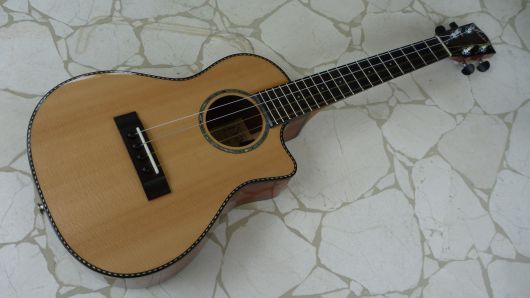Installing a Wittman MiniTuner – In an `Ukulele
I use an electronic tuner for my stringed instruments. I use one often. When I tune by ear I do a terrible job, so I much prefer using a gadget to help me. I’ve tried lots of different tuners over the years. When I played mainly electric guitar I used tuners with 1/4″ jack inputs. When I moved over to acoustics, I often used the Sabine stick-on tuners. But things changed when I discovered the Wittman MiniTuner – I started installing these inside all my acoustic guitars.
The Best Tuner Is Built-in
It’s hard to appreciate just how convenient this device is. First, it’s always handy, your picking buddy can’t borrow the tuner unless you lend him the whole guitar!! You’ll never put it down and forget it, never leave it behind at a gig, never have one of the kids play with it and run the battery down. Another hassle you avoid is the visibility problem. The lights are bright and the tuner is in a nice dark space inside the instrument, so visibility is better than any other tuner I’ve ever used.
The tuner is fully chromatic, that is, you can tune to any standard pitch, not just standard guitar tuning. This is very handy for my slack key because we tune to flats and sharps as well as natural notes up and down the scale. The Wittman has a clear marking for the sharp/flat interval between the natural scale notes.
It’s Not Perfect
There are some limitations to the Wittman MiniTuner. The reference pitch is not adjustable, so it doesn’t have the ability to match an out of tune piano or horn. The tuner senses body vibrations, so it can be difficult to use in very loud conditions where your instrument is affected by the sounds around you. If your bass player is tuning up or noodling at performance volume the Wittman is going to be very hard to use. The other big issue is that you wind up buying a separate tuner for each instrument. This makes the Wittman an unhappy choice for those on a strict budget. Perhaps I should economize, but the darned thing is just addictive. In fact, many of my friends, even those who scoff at first, wind up installing one of these tuners. I decided to try installing one of them in my `ukulele, a lovely little Pono tenor cutaway, mahogany and spruce.
Pono is the off-shore brand of the Ko`olau Guitar & Ukulele Company, the Kitakis family of O`ahu. My Ko`olau tenor is a treasure and my favorite uke, but I’ve always had a guitar geek’s desire for a cutaway tenor with a pickup, and this Pono fits the bill perfectly.
Here’s a video of the installation process.
Now that I’m reviewing the process I can see that I did it quite the hard way. The sticky-back velcro attachment system makes it easy to fit just one half the velcro first. With the velcro in place it’s a snap to install the battery holder and tuner. Still, even if I didn’t demonstrate the best way, I hope you can see that it’s a pretty simple job to install one of these. And if you’re like me, once you try it, you’ll be hooked.
This entry was posted on Thursday, February 11th, 2010 at 4:08 pm and is filed under Guitar, Tutorials. You can follow any responses to this entry through the RSS 2.0 feed. You can leave a response, or trackback from your own site.

Jad said in post # 1,
on April 29th, 2010 at 12:28 am
Hi there, great video. I couldn’t see where you put the battery bag in the guitar. Is it on the same side up as the tuner or is it in the base of the sound hole.
Thanks.
Jad
Fran Guidry said in post # 2,
on April 29th, 2010 at 8:03 am
I mounted the battery on the back of the uke, on the same side as the tuner. It’s kind of tucked into the cutaway. Anywhere is fine, as long as it’s not touching and damping the top.
Fran
Jad said in post # 3,
on April 29th, 2010 at 11:57 pm
Great! Many thanks, I ordered one 🙂
James Voos said in post # 4,
on September 29th, 2011 at 4:09 pm
Love your tenor Uke, particularly the rope binding. Which model is this, and if you don’t mind me asking, what does one of these cost?
Fran Guidry said in post # 5,
on September 29th, 2011 at 5:43 pm
The uke is Pono by Ko`olau `Ukulele and Guitar, O`ahu, HI. http://www.koolauukulele.com/
Here’s his current price list: http://www.koolauukulele.com/pono.html
Unfortunately their models change year by year, so this one from a few years ago is not in current production.
Fran